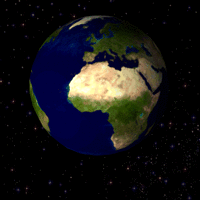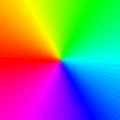Graphics Interchange Format facts for kids

A rotating globe in GIF format. Posterization is noticeable in the blue gradient areas due to the restricted palette.
|
|
| Filename extension |
.gif
|
|---|---|
| Internet media type |
image/gif
|
| Type code | GIF GIFf |
| Uniform Type Identifier (UTI) | com.compuserve.gif |
| Magic number | GIF87a/GIF89a |
| Developed by | CompuServe |
| Type of format | Raster graphics image format |
The Graphics Interchange Format (often called GIF) is a special type of file format for images. It's like a container for pictures on computers.
GIFs are a kind of raster graphics format. This means the image is made of tiny dots (pixels) and has a fixed size. CompuServe, a company, created and launched the GIF format in 1987. Today, you can see GIFs everywhere on the World Wide Web.
GIFs can show up to 256 different colors at once. This is why they are not often used for photographs. Photos usually need many more colors to look real. But GIFs are great because they can also show animations! Each part of an animation can even have its own set of 256 colors.
To make GIF files smaller, they use a special method called Lempel–Ziv–Welch compression. This method is "lossless," meaning no information is lost when the image is made smaller or brought back to its original size. There were some issues with the patent for this compression method, which was owned by a company called Unisys. These problems led to the creation of another image format called PNG. But don't worry, these patent issues are no longer a problem today.
Animated GIF: Pictures That Move!

One of the coolest things about GIFs is that they can be animated. This means they can show a series of pictures one after another, creating a short video clip. Think of it like a flipbook!
An animated GIF file holds many different pictures, called frames. Each frame is shown for a short time, one after the other. This makes the images appear to move. The file tells the computer how long to wait before showing the next frame.
By default, many animated GIFs will play their sequence of frames only once. They stop when the last picture is shown. But many GIFs are also set to loop forever, playing the animation over and over again.
Images for kids
-
A funny image from the White House about their new Tumblr page. It suggests saying GIF with a hard g sound.
See also
 In Spanish: Graphics Interchange Format para niños
In Spanish: Graphics Interchange Format para niños





